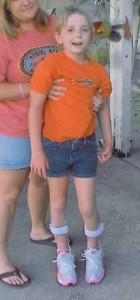Kaylee’s grandmother thought she was doing the best thing for her family when she researched and settled on trading in her car for a new Chevrolet Venture minivan to take her grandchildren to and from school each day.
One of her criteria for safety was that her new vehicle had to have side impact airbags like her Cadillac sedan had.
But, despite marketing materials that made it seem like her new minivan had side impact airbags to provide protection for her and her granddaughter, the fact was that only she and the right front passenger would ever get the safety benefits of life-saving side airbags in an accident.
While the front seats had side airbags, her most valuable cargo, her granddaughter, who sat in the “safer” rear seat, was seated in an area where no airbags had been incorporated for occupant protection. While parents are constantly told to place children in the rear of their vehicles for their own safety, the sad reality is that many cars do not have the same protective side impact airbag safety features in the back seats as are provided for the front seated driver and passenger.
With safety being a hot selling point for vehicles these days, auto manufacturers have shifted their marketing focus to highlight its vehicle’s safety systems, sometimes without making it clear what is actually included and what is not. When a car advertises that it has side airbags, one would assume these side airbags extend throughout the vehicle. But, consumers don’t realize these airbags may not necessarily extend beyond the front row.Unlike the stringent regulations for frontal airbags, NHTSA does not regulate the design or placement of rear airbags. Therefore, customers can be left with less protection than they believed they have. This is what happened to the Foll family, and the results were devastating.
Kaylee was a typical 9-year-old girl. She enjoyed typical childhood activities such as jumping on trampolines, fishing, four-wheeling, playing sports and dancing with friends. She was very proficient in math and drawing. She also competed in gymnastics and dreamed of becoming a cheerleader one day.
But, on April 6, 2006, just as she was blossoming into a vibrant young girl, her life was forever changed. Kaylee and her two siblings were in their grandmother’s Chevrolet Venture minivan, buckled up and on their way to school. As her grandmother began to make a left-hand turn onto the local State Road, a dump truck traveling southbound on that road at a reported speed of 35 miles per hour ran a red light and pummeled into the left side of the minivan. While her grandmother walked away, Kaylee, who was seated on the same side of the car as her grandmother but did not get the same safety benefits of an airbag deployment to protect her, was severely injured.
The aftermath of the accident has been unforgiving. Kaylee sustained a debilitating brain injury and resultant physical limitations, in particular, left sided hemiparesis, which will affect her physical and mental abilities for the rest of her life.
Today, Kaylee has very limited use of her left side, primarily relies upon a wheelchair for mobility, and utilizes leg braces and a walker on a limited basis to stand. Kaylee has a hard time balancing, has a lack of coordination, endurance, range of motion, and muscle weakness. She scores in the 1st percentile in motor ability, making it particularly difficult, and even impossible in some instances, to participate in the things she once enjoyed.
The brain injury has also drastically altered her cognitive ability. Kaylee’s performance with regard to speech, writing, reading comprehension have all been reduced to well below her grade level.
At age 10, she scored at kindergarten, 1st and 2nd grade levels. Deficits in attention, understanding, comprehension, impulsivity, and distractibility, hinder her ability to function independently and perform in a classroom like other children her age.
How could this tragedy have been avoided? Though Kaylee’s accident might not have been preventable, head-protecting side airbags would have reduced the likelihood of injuries to Kaylee and given her a much better chance of walking away unharmed. General Motors and other manufacturers have long understood the risks of head injuries that result from side impact crashes, and, from a safety perspective, it is hard to dispute the fact that one of the most effective ways to protect occupants in side impact crashes is to design in side airbag technologies.
Side airbags for rear-seated occupants are increasingly being used, yet a decade worth of vehicles without them still remain on the road. Until such safety systems are universally used, consumers must be aware of what they are getting when they buy or rent a car, minivan or light truck, and be vigilant for the safety of their rear-seated children and passengers.
.




